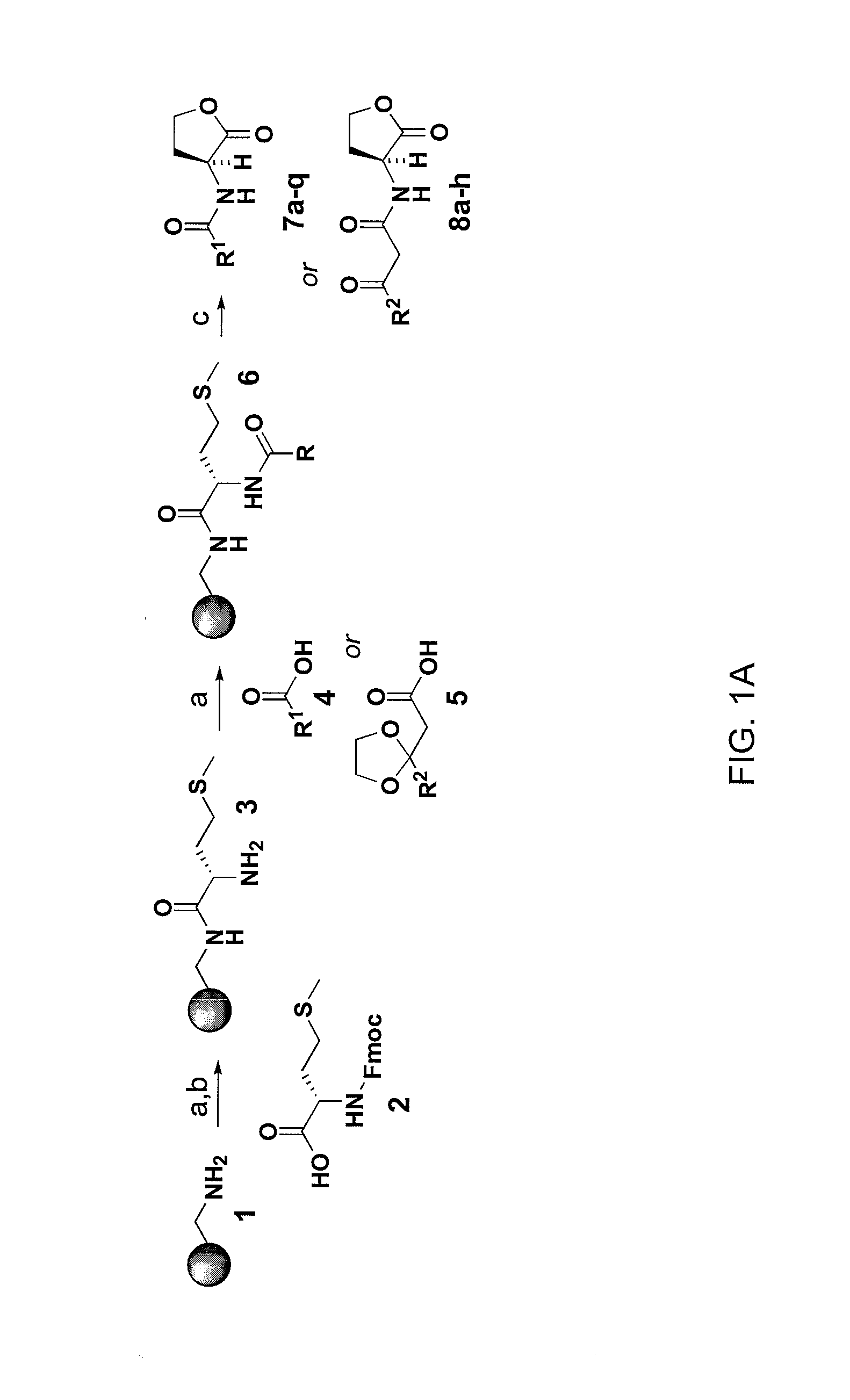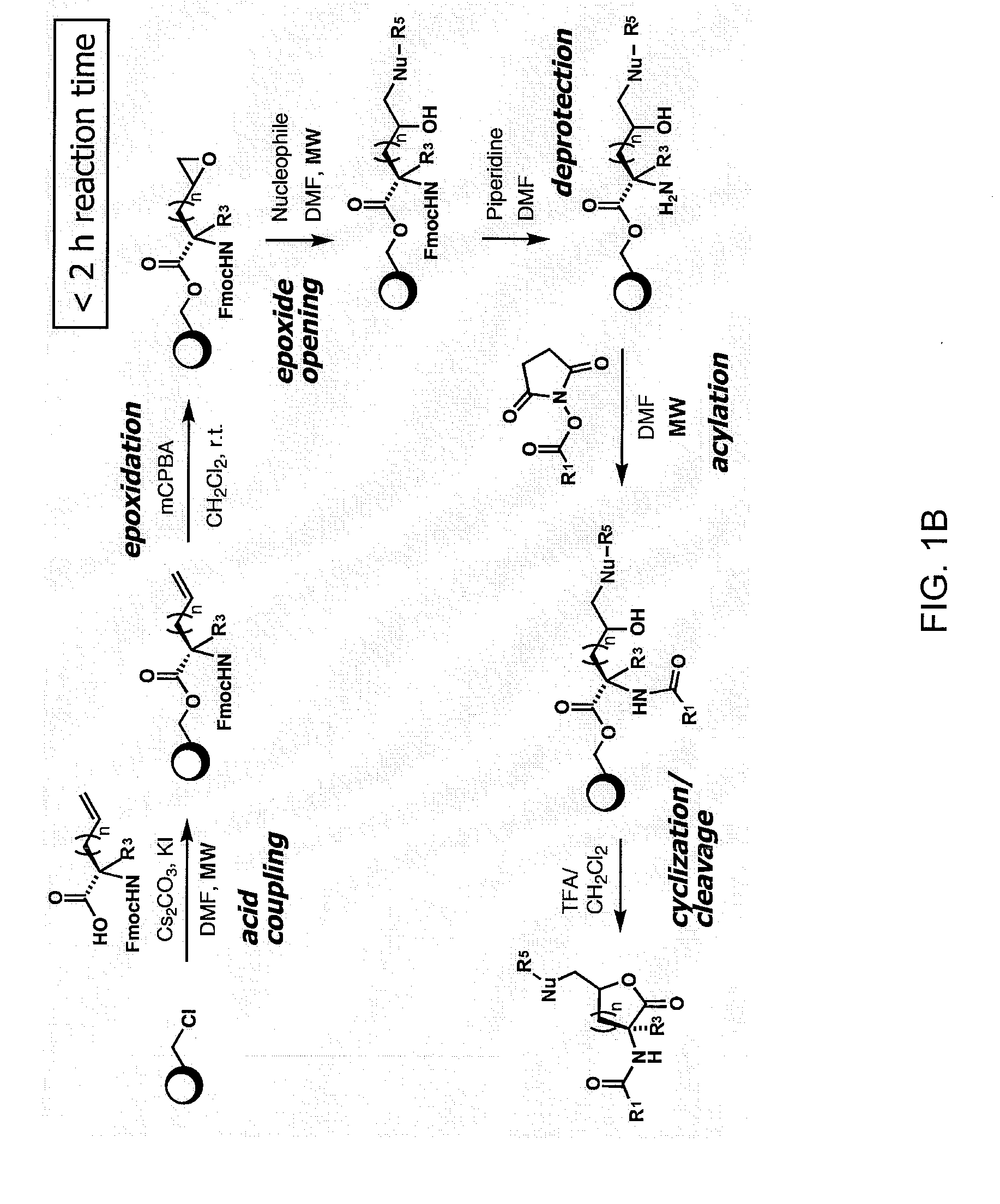Compounds and methods for modulating communication and virulence in quorum sensing bacteria
- Summary
- Abstract
- Description
- Claims
- Application Information
AI Technical Summary
Benefits of technology
Problems solved by technology
Method used
Image
Examples
example 1
Synthesis of 3-Oxooctanoic Acid (10b) (SCHEME IV)
[0108] A stirred solution of bis-trimethylsilyl malonate (21.6 g, 71.5 mmol) in 100 mL of anhydrous diethyl ether was cooled to −78° C. To this solution, n-butyl lithium (1.6 M in ether, 44.7 mL, 71.5 mmol) was added slowly, keeping the temperature below −60° C. Upon completion of addition, the reaction was allowed to warm to −10° C., at which time hexanoyl chloride (5 mL, 35.75 mmol) was added quickly and allowed to stir for 30 minutes. Next, 150 mL of a cold, aq. 5% sodium bicarbonate solution was added, and the resulting solution was stirred vigorously for 30 minutes. The aq. layer was separated out and acidified with cold 4N sulfuric acid until pH=2. The aq. layer was then extracted 2×50 mL with diethyl ether, dried over MgSO4, and concentrated down in vacuo to afford a white solid. This solid could be further purified by recrystallization from hexane, if necessary. 4.9 g, 87% yield. 1H NMR (300 MHz, CDCl3) δ=3.49 (s, 2H, CH2), 2...
example 2
Synthesis of Methyl-3-Oxooctanoate (11b) (SCHEME V)
[0109] To a stirred solution of 10b (5.5 g, 35 mmol) in 150 mL of a 4:1 mixture of benzene and methanol, TMSCHN2 in diethyl ether (2M, 21 mL, 42 mmol) was added over a period of 10 minutes. The reaction was allowed to stir for 30 minutes, after which the reaction mixture was concentrated in vacuo to afford 11b as a yellow oil. This material was used in the subsequent step (SCHEME IV) with no further purification. 6.1 g, 95% yield. 1H NMR (300 MHz, CDCl3) δ=3.73 (s, 3H, CH3) 3.44 (s, 2H, CH2), 2.55 (t, 2H, J=7.3 Hz, CH2), 1.64 (p, 2H, J=7.4 Hz, CH2), 1.36 (m, 4H, CH2CH2), 0.91 (t, 3H, J=6.9 Hz, CH3); 13C NMR (75 MHz, CDCl3) δ=202.9, 167.9, 128.5, 52.7, 49.2, 43.2, 31.3, 23.3, 14.0 ppm.
example 3
Synthesis of 3,3-Ethylenedioxooctanoic Acid (5b) (SCHEME VI)
[0110] To a stirred solution of methyl-3-oxooctanoate (11b) (5.6 g, 32.5 mmol) in 125 mL of benzene, ethylene glycol (20.2 g, 325 mmol) and pTsOH (0.617 g, 3.25 mmol) was added. The flask was equipped with a condenser and Dean-Stark trap and heated to reflux for 24 h. The reaction mixture was concentrated in vacuo and diluted in 100 mL of diethyl ether. The organic layer was washed with 2×25 mL of 10% aq. NaOH, then 2×25 mL of saturated NaCl solution, dried over MgSO4, and concentrated in vacuo to afford a clear oil. This oil was subjected to saponification by treatment with 1N NaOH (150 mL) and MeOH (75 mL) for 6 h. The basic solution was concentrated in vacuo, chilled in an ice bath, and acidified with cold concentrated HCl to a pH=2. The acidified solution was extracted with 2×75 mL of diethyl ether, dried over MgSO4, and concentrated in vacuo to afford 3,3-ethylenedioxooctanoic acid 5b as a clear oil. 3.3 g, 50% yield....
PUM
| Property | Measurement | Unit |
|---|---|---|
| Fraction | aaaaa | aaaaa |
| Fraction | aaaaa | aaaaa |
| Fraction | aaaaa | aaaaa |
Abstract
Description
Claims
Application Information
 Login to View More
Login to View More - R&D
- Intellectual Property
- Life Sciences
- Materials
- Tech Scout
- Unparalleled Data Quality
- Higher Quality Content
- 60% Fewer Hallucinations
Browse by: Latest US Patents, China's latest patents, Technical Efficacy Thesaurus, Application Domain, Technology Topic, Popular Technical Reports.
© 2025 PatSnap. All rights reserved.Legal|Privacy policy|Modern Slavery Act Transparency Statement|Sitemap|About US| Contact US: help@patsnap.com



